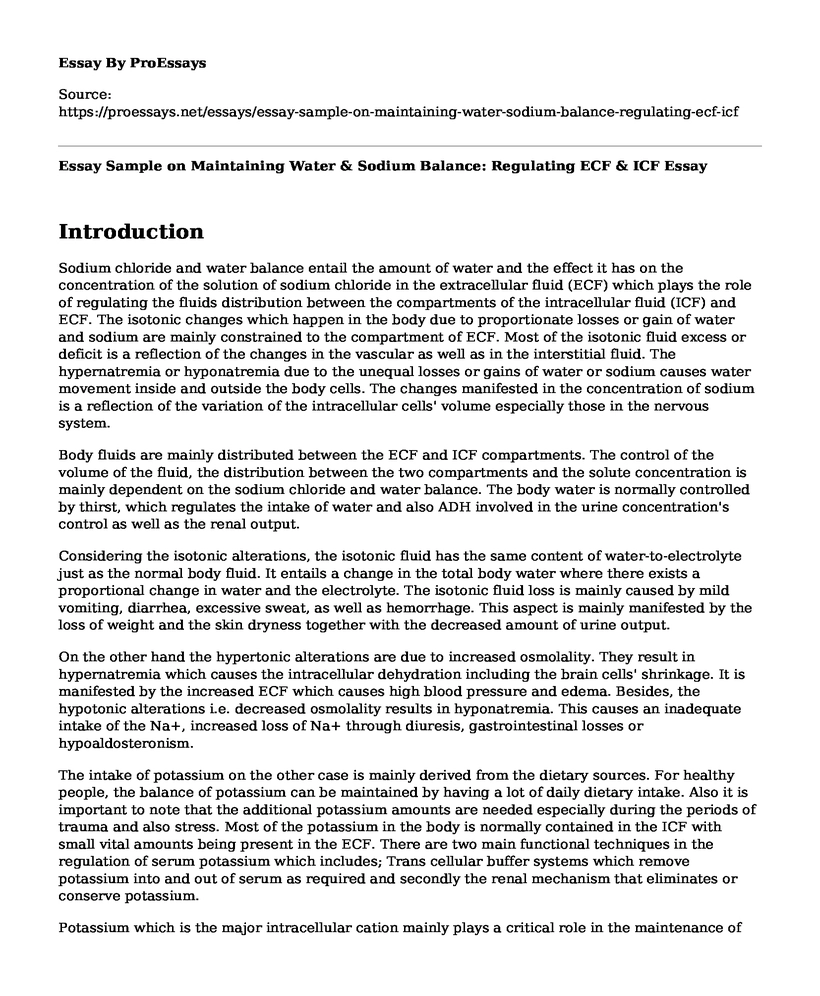Introduction
Sodium chloride and water balance entail the amount of water and the effect it has on the concentration of the solution of sodium chloride in the extracellular fluid (ECF) which plays the role of regulating the fluids distribution between the compartments of the intracellular fluid (ICF) and ECF. The isotonic changes which happen in the body due to proportionate losses or gain of water and sodium are mainly constrained to the compartment of ECF. Most of the isotonic fluid excess or deficit is a reflection of the changes in the vascular as well as in the interstitial fluid. The hypernatremia or hyponatremia due to the unequal losses or gains of water or sodium causes water movement inside and outside the body cells. The changes manifested in the concentration of sodium is a reflection of the variation of the intracellular cells' volume especially those in the nervous system.
Body fluids are mainly distributed between the ECF and ICF compartments. The control of the volume of the fluid, the distribution between the two compartments and the solute concentration is mainly dependent on the sodium chloride and water balance. The body water is normally controlled by thirst, which regulates the intake of water and also ADH involved in the urine concentration's control as well as the renal output.
Considering the isotonic alterations, the isotonic fluid has the same content of water-to-electrolyte just as the normal body fluid. It entails a change in the total body water where there exists a proportional change in water and the electrolyte. The isotonic fluid loss is mainly caused by mild vomiting, diarrhea, excessive sweat, as well as hemorrhage. This aspect is mainly manifested by the loss of weight and the skin dryness together with the decreased amount of urine output.
On the other hand the hypertonic alterations are due to increased osmolality. They result in hypernatremia which causes the intracellular dehydration including the brain cells' shrinkage. It is manifested by the increased ECF which causes high blood pressure and edema. Besides, the hypotonic alterations i.e. decreased osmolality results in hyponatremia. This causes an inadequate intake of the Na+, increased loss of Na+ through diuresis, gastrointestinal losses or hypoaldosteronism.
The intake of potassium on the other case is mainly derived from the dietary sources. For healthy people, the balance of potassium can be maintained by having a lot of daily dietary intake. Also it is important to note that the additional potassium amounts are needed especially during the periods of trauma and also stress. Most of the potassium in the body is normally contained in the ICF with small vital amounts being present in the ECF. There are two main functional techniques in the regulation of serum potassium which includes; Trans cellular buffer systems which remove potassium into and out of serum as required and secondly the renal mechanism that eliminates or conserve potassium.
Potassium which is the major intracellular cation mainly plays a critical role in the maintenance of the intracellular osmolality which is required for the normal neuromuscular function, drop in the serum potassium level results in the hypokalemia. This can arise from the excessive losses, inadequate intake, or even the redistribution of between the compartments of ECF and ICF. It rarely occurs in healthy people since the body is powerful and effective in prevention of excess accumulation of potassium in the ECF. The main causes are decreased renal elimination of potassium and the trans-cellular shift in potassium out of the cell to the compartment of the ECF.
References
Clark, B. A., & Brown, R. S. (2012). Potassium homeostasis and hyperkalemic syndromes. Endocrinology and metabolism clinics of North America, 24(3), 573-591. https://www.sciencedirect.com/science/article/abs/pii/S088985291830032X
Fried, L. F., & Palevsky, P. M. (2006). Hyponatremia and hypernatremia. Medical Clinics of North America, 81(3), 585-609. https://www.sciencedirect.com/science/article/abs/pii/S0025712505705356
Huether, S. E., & McCance, K. L. (2015). Understanding Pathophysiology-E-Book. Elsevier Health Sciences. https://pdfs.semanticscholar.org/45ad/673f9e63a1477b1a6aea3b9f94e0b48bee35.pdf
Cite this page
Essay Sample on Maintaining Water & Sodium Balance: Regulating ECF & ICF. (2023, Feb 06). Retrieved from https://proessays.net/essays/essay-sample-on-maintaining-water-sodium-balance-regulating-ecf-icf
If you are the original author of this essay and no longer wish to have it published on the ProEssays website, please click below to request its removal:
- Do Cell Phones Cause Cancer?
- Essay Sample on Beyond Blue
- Research Paper on Pacific Tsunami Warning System: Ensuring Safety for 26 Member Countries
- The Responsibilities of Nurses in the Care and Handling of a Child
- Leadership Nursing: Creating Positive Change in Healthcare - Research Paper
- Nursing Synthesize Task: Examples, Learning, and Future Use - Essay Sample
- Essay Example on SLE: Systemic Lupus Erythematous, A Widespread Inflammatory Disease







